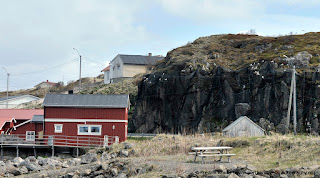The kittiwake / krykkje / tretåig mås (Rissa tridactyla) is a seabird species breeding on cliffs along the coasts of the north Pacific and north Atlantic. In Norway, the main distribution of kittiwakes is in the northern parts of the country. They are primarily fish feeders, and are much more pelagic than other gulls outside the breeding season and do not scavenge at garbage.
Kittiwakes (Rissa tridactyla)
The Norwegian Institute for Nature Research,
NINA, have monitored the populations of seabirds in Norway for the last 30 years, and their research show a very clear and dramatic decrease in numbers of kittiwakes in Norway. Since the monitoring started, the population of kittiwakes have decreased by 70-85 % and the number of kittiwakes is now only a small fraction of what it used to be.
This dramatic development has accelerated during the last couple of years and in 2010 the status of kittiwakes on the Norwegian Red-List changed from Vulnerable (VU) to Endangered (EN).
Dead kittiwake under the colony
It was, therefore, with a small shock that I noted that the local colony of kittiwakes here in the fishing village of Stø in Vesterålen in Northern Norway was covered with a large net this season. Already last year there were some small remains of an old net in the upper part of the colony where both dead kittiwakes and kittiwakes entangled in the net were found. Needless to say, the number of breeding pairs also in this colony has now decreased.
Net has been put up in the kittiwake colony to prevent the birds from breeding
Gunnartangen argues that the birds can not get entangled in the net !
Who puts up a net in a colony of an endangered species and why? The answer turned out to be the owner of
Gunnartangen Rorbuferie, an operator that offers accomodation in Stø with the slogan on their web-page: "Welcome to a vibrant fishing village in Vesterålen, where you can enjoy the nature both on land and by sea - winter and summer"
Gunnartangen Rorbuferie with the kittiwake colony in the background
In an extensive article on NRK (Norwegian News);
here it is shown how the owner explains that the kittiwakes are chasing the tourists away, agressively attacking people and that most inhabitants in Stø wants them gone. In addition, he explains that he was there first and that the kittiwakes must leave. He also argues that the net is constructed in a way that the birds can`t get entangeled. The authorities, are, however of another opinion and classifies the net as fauna-criminality.
This is puzzling, because many that offer similar accomodation are happy to have kittiwakes close by and/or on their accomodations, and tourists and guests in the village are delighted to take pictures of the birds and even at a distance of 2m from the birds the kittiwakes hardly even bother to look at you, and they definitely do not attack.
Passing by the kittiwakes is perfectly safe
Dead kittiwake beneath the colony
To point out that the arguments are far from both the truth and the public opinion I have therefore published a short report together with the Norwegian Ornithological Society (NOF) today;
NOF-report about the kittiwakes in Stø and I encourage anyone with experience from their stay in Stø to contact Gunnartangen and express their views (good or bad) in order to give the owner a realistic view of what they have experienced. Contact;
Gunnartangen Rorbu-Ferie
Like in most fights between endangered species and humans, one side is heavily armed while the
other side doesn`t even know there is a war going on and if there is not room for both people and birds in a fishing village, then something is very wrong indeed...

















